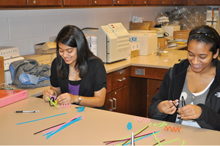
for Structural Bioinformatics Protein Data Bank
Number 49
| EDUCATION
CORNER Building Protein Structures and the Molecule of the Month Understanding proteins and their 3D shapes presents a real challenge for high school biology students. Just the definitions of proteins and protein folding, available from textbooks and the Internet, can lead students to avoid these topics and scramble for their Xboxes. For some examples:
Trying to make sense of this information and having a real understanding of the function of a protein is difficult. The complexity of the new protein data that is being published at hyper-speed has left most high school students in the dust. Not only is it hard to explain protein biochemistry, but now we also have the genome, glycome, and proteome. That is why resources like the RCSB PDB are extremely valuable in trying to bring students up to speed and get them excited about the possibilities for the future. The work of Phil McFadden in his protein portraits course was an awesome view of various protein structures. (3) Using protein model competitions is a great way to get students excited about building models, and it shows the fun and creativity of participating in this activity.
The RCSB PDB is a resource that encourages model building and has user-friendly tutorials that guide students through various simulations. My favorite feature is the Molecule of the Month by David Goodsell. These molecules are presented in such a way that enables students to really understand multiple aspects of a particular protein. The Molecule of the Month for April 2003 was RNA polymerase. This entry clearly explains the structure and function of RNA polymerase, and describes how it accurately copies genetic information. High school students typically learn about RNA polymerase and its role in transcribing DNA, but the RCSB PDB takes it one step further by including a section on how RNA polymerase can be poisoned. Students are able to see how a toxin can bind to RNA polymerase and interfere with its function. This, of course, leads to a new discussion on where that toxin would exist in nature, and what happens if you get exposed to it? Is there a treatment? That then leads to the discussion about the death cap mushroom - and now, you're introducing students to fungal biology. (4) When you get the opportunity to link the structure and function of a protein to medical conditions, this gets their attention and they see the significance of the shape of one molecule fitting the shape of another. I recommend the Molecule of the Month resource to any teacher who works with proteins and is looking for real practical applications.
The common theme, however, that arises in building these proteins is that whatever structure you create (and using whatever materials), you can easily see how domains develop that allow for some other molecule to fit that shape and interact with your protein. This is probably the best message you can impress upon high school biology students, and the RCSB PDB is a resource that gives anyone who teaches or wants to learn about proteins the opportunity to explore that concept. References: 1. B. Alberts, A. Johnson, J. Lewis, M. Raff, K. Roberts, P. Walters (2002) Molecular Biology of the Cell (Fourth Edition). New York and London: Garland Science. 2. A. Lehninger, D.L. Nelson, M.M. Cox (2005) Lehninger's Principles of Biochemistry (Fourth Edition). New York, New York: W. H. Freeman and Company. 3. P. McFadden (2010) Undergraduate Course: Protein Portraits. RCSB Protein Data Bank Newsletter 46:8-11. 4. D. Arorad (1986). Mushrooms Demystified: A Comprehensive Guide to the Fleshy Fungi. Berkeley, California: Ten Speed Press. |
E-mail: info@rcsb.org • Web: www.pdb.org • FTP: ftp.wwpdb.org
The RCSB PDB is a member of the wwPDB (www.wwpdb.org)




